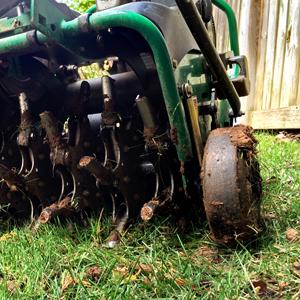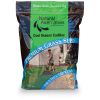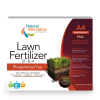It’s time to think about the fall lawn – seeding and fertilizing. Now is when the days get shorter and the temperatures get cooler. It may seem strange, but fall is actually the best time to make improvements to your lawn. If you seed and feed the lawn in fall, you will establish the foundation for a thicker and healthier lawn in the spring.
Seed
As turfgrass matures, the rate at which it spreads to create a thick, dense lawn slows. It is important to keep a consistent overseeding routine to prevent bare spots or a thinning lawn. New grass seedlings fill in the gaps and spread quickly to reduce weeds. Introducing new seed varieties each year, will also help the lawn fight off any future attacks by disease, insects or drought.
Prepare The Area
- Remove lawn debris. (Sticks, leaves, stones, etc.)
- Prepare the soil for seeding to maximize germination. Considering dethatching the lawn with a simple yard rake, a tow-behind attachment on your rider lawnmower or a standalone unit known as a power rake, obtained from an equipment rental store.
- If your soil is compacted, consider aerating it. Otherwise, it will be difficult for seedlings to take root and absorb nutrients. Like the power rake, you can rent an aerator at your local equipment store or contact a lawn care professional to provide this stand-alone service. (See our article on Preparing the Lawn for Aeration).
Sowing Seeds
You can apply seed by hand, or with a handheld spreader, a push spreader, a tow-behind spreader or a power seeder (also known as a slit seeder). Spreading seed by hand or using a handheld spreader is great for tight spaces and around landscaping. Large areas are best covered with a broadcast push spreader, which will cover the most ground in a single pass. Power seeders can be rented from home improvement centers as needed.
Seed Types & Application Rates
- Determine the seed blend that works for you by assessing how much sunlight your lawn gets. Is it in sun, shade or a combination?
- Is your lawn used heavily by children and pets, or is it more of an aesthetic lawn?
- Does the area you live in experience frequent droughts?
- How many square feet of lawn will you be overseeding?
- How many pounds of grass seed per 1,000 square feet do the instructions on the bag recommend? Multiply the square feet of lawn space by the number of pounds per 1,000 square feet to determine how many pounds of grass seed you will need.
Unsure of which grass seed to use or how much you need? No problem. Call us at 888-546-5941, and one of our customer care specialists will help you.
Feed
Once you apply the seed, it needs food and water to grow. For fall seeding, a “starter” fertilizer like Recuperator 7-10-4 with higher concentrations of nitrogen, phosphorus and potassium is recommended. While starter fertilizers contain higher levels of nutrients they are water soluble and formulated so they do not burn the young grass seed plants.
Water frequently and lightly in order to keep the seeds and soil moist, but not soaked. After about two weeks, or when the new seedlings have grown about two inches, you may mow the grass. Be sure to use a sharp blade to prevent pulling seedlings out.
For more information, sign up for our e-newsletter, The Monthly Dirt, follow our social channels or give us a call for the latest seasonal tips and DIY know-how.






